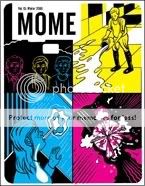MOME Vol. 13: Winter 2009
Eric Reynolds, Gary Groth, editors
David Greenberger, Tim Hensley, Dash Shaw, Conor O’Keefe, Gilbert Shelton, Pic, Josh Simmons, T. Ott, Kurt Wolfgang, Nate Neal, Laura Park, Sara Edward-Corbett, Derek Van Gieson, Kaela Graham, Adam Grano, Henry Huntington, Casey Jarman, writers/artists
Fantagraphics, November 2008
120 pages
$14.99
Something about this volume of MOME makes it my least favorite in a while. It’s entirely possible that it just caught me on an off day, or that I’m all anthologied out. But while there’s always a tension in MOME between the best material it contains and the lesser stuff, and while that’s always been a big part of why I enjoy the series so much, I feel like we’re starting to see those two qualitative groups coalesce around two separate ways of doing comics. It’s almost like MOME is becoming two anthologies at once, and my problem with that is I’m not sure which one will win out in the end.
On the one hand, you have experimental takes on genre. In this volume, that school is represented by Dash Shaw’s dystopian science fiction, Tim Hensley’s continuing riff on Archie comics “Wally Gropius,” Derek Van Gieson’s Scary Stories to Tell in the Dark-type fable, a wordless journey into space with T. Ott, and Josh Simmons’s latest savage horror comic. It probably doesn’t surprise anyone that this is where my sympathies lie. Shaw’s “Satellite CMYK” comes first, telling the story of a Battlestar Galactica-esque satellite colony of survivors that has become so rigidly stratified that the mere existence of other levels of the structure is the subject of 1984-Brotherhood-style subversive conspiracies. Shaw conveys this idea by using a different color for each level. It’s not quite successful–the sameness of Shaw’s faces makes it harder to follow than it ought to be, and the power of the final reveal image is undercut by needless captions–but it’s as ambitious, imaginative, and emotionally rooted a bit of SF worldbuilding as any of Shaw’s work in this area. Hensley’s “Gropius” stuff continues to fascinate me with its angular character designs, kinetic non-action, and subtext of high-capitalist violence. (Riverdale this ain’t.) Van Gieson’s strip took me a couple reads to figure out that it was, in fact, a strip and not a series of discrete vignettes, but once I grokked what was going on, I really dug (no pun intended) that final graveside kicker, and the Gorey/L’Autrec/Alvin Schwartz watercolor visuals. Simmons, finally, can seemingly do no wrong anymore. I’m having a hard time coming up with any cartoonist whose work is as angry as Simmons’s has been lately. House, Jessica Farm, “Batman,” “Night of the Jibblers,” and this issue’s “Jesus Christ” (!) are breathtaking in their brutal nihilism–it’s horror that aims to punish, to tear down. In this case that’s literally the plot: a gigantic centaur-like Messiah descends from the heavens simply to wreak havoc on the tiny inhabitants of the endless city in which he lands. He’s too big for them to comprehend, physically or mentally, and their lives couldn’t matter less to him. It’s Lovecraft’s cosmic horror by way of the undergrounds’ hyper-detailed art (those buildings! that smoke! that bravura sequence when Jesus regurgitates a flaming sword!), taboo-shattering violence, and full-frontal nudity. Follow it with an equally bleak scratchboard science-fiction parable by Thomas Ott and you’ve got a heck of a one-two punch.
But then. The other pole is whimsy, and here’s where MOME loses me. This issue’s David B./Jim Woodring-style guest star is underground stalwart Gilbert Shelton, who serves up a limp, laughless story about his shitty recurring rock band Not Quite Dead being secretly sent by the government to overthrow the government of a banana republic. Sure, he draws the living shit out of it, but the whole thing feels so far past its sell-by date–a Grateful Dead spoof with jokes about hot-button cultural touchstones Elvis Presley and Madonna? Rock ‘n’ roll using its awesome power to subvert civil authority?–that it doesn’t make a difference. Underground-indebted MOME regular serves up a strange story about a folk singer named Minnie, drawn to look a lot like Phoebe Gloeckner’s similarly named stand-in character for no discernible reason; it’s a story about bein’ down n’ out and just wantin’ to play th’ blooz and it sucks that Greenwich Village is filled with yuppie scum now and blah, blah, blah. It’s nice-looking enough, but I don’t come away from it feeling or thinking anything new. Conor O’Keefe’s McKay-like figurework and Sara Edward-Corbett’s sharp Partyka-bred line (as well as her “Rabbithead”-indebted tiered narrative) cut through the ugly-cute clutter, as does Laura Park’s suite of strips about things she’s done at night (look at that quilt!), so it’s not as though the lighter/zanier material is completely undistinguished…I don’t know, I guess I just wasn’t in the mood. I definitely don’t know why we needed page after page of David Greenberger listing album titles according to the number of syllables they contain, you know? And that kind of decision makes me nervous for the future of the anthology.
Tags: comics, comics reviews, Comics Time, reviews


3 Responses to Comics Time: MOME Vol. 13: Winter 2009